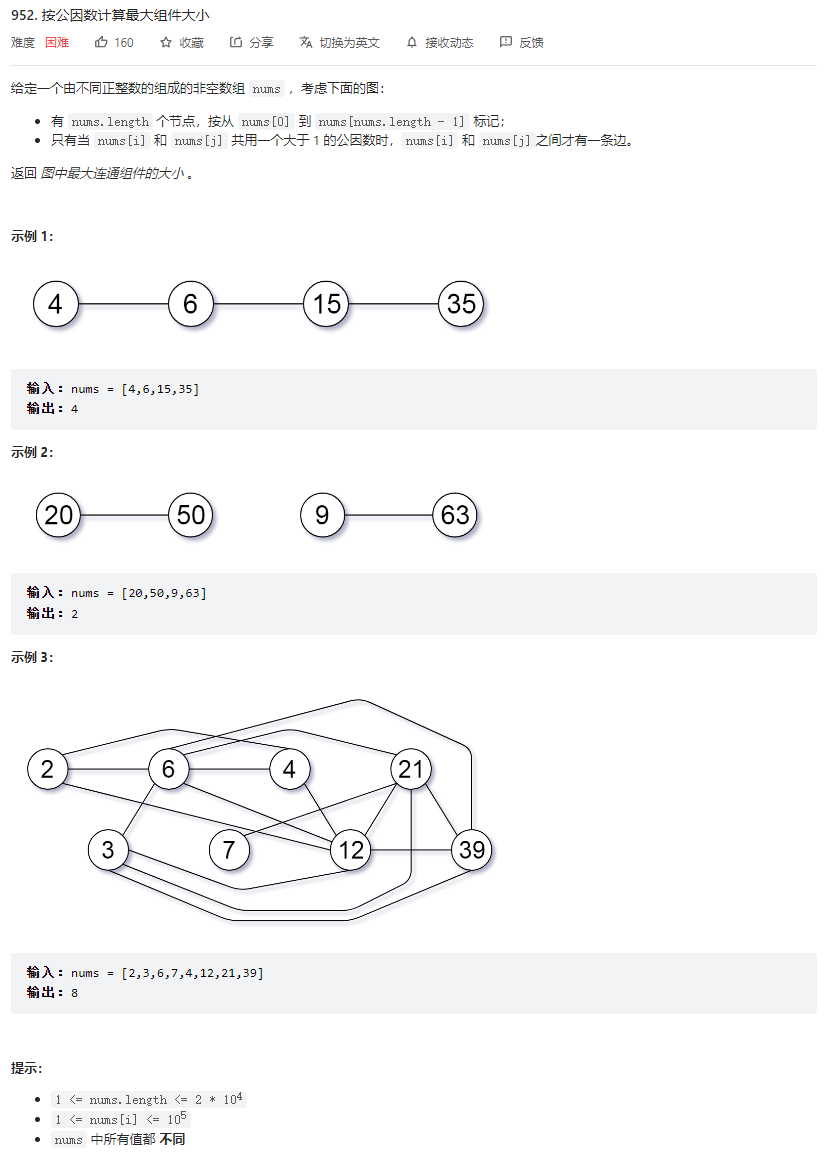
题目分析
这是一个困难题,其实难度并没有这么大,就看小伙伴们有没有想到这个方法。
BFS
本题目是将有公因数的数字连起来,求最大的数字集合。我们思考一个小技巧,两个数是否有公因数,是不是要计算两者所有的因数呢?假如A和B有一个公因数C,C并不是一个质数,那么C可以分解成E x F,那么E和F也一定是A和B的公因数,因此我们只需要求出某个数的质数因子即可。
例如32和84是连通的。并不需要求32的所有因数,2、4、8、16、32,求84的所有因数2、3、4、6、7、12、14、21、28、42、84。而是只要将32拆分成2 x 2 x 2 x 2 x 2,即因数只有2,将84拆成2 x 2 x 3 x 7,即因数只有2、3、7。
一开始想到的是BFS算法,用numToFactor表示某个数的质因子,factorToNum表示某个质因子可以找到哪些数。并且用visitedFactor表示访问过的质因子,用visitedNum表示访问过的数。
此时可以从第一个数开始遍历,将质因子都加入到队列中,然后取出队列中的质因子,每个质因子都会从factorToNum中找到所有相关的数字,并将这些新找到的数字对应的质因子加入到队列中。
设有n个数字,数字的最大值为m,算法每个数字都只会访问一次,访问每个数字都需要$\sqrt(m)$的时间求出质因子,因此算法的*时间复杂度为$O(n\sqrt(m))$,要记录每个数的所有质因子、每个质因子相关的数字,因此空间复杂度也是$O(n*\sqrt(m))$**。
下面是Java语言的题解
1 | class Solution { |
并查集
BFS算法虽然能通过本题,但是构造了太多的Map和Set存储数据,而且逻辑也比较复杂,queue里面存放的是质因子,要根据质因子找到相关的数字,然后再根据数字找到质因子放入queue。queue里面存放数字也一样,要根据数字找到质因子,然后根据质因子找到相关数字放入queue。
对于这种连通问题,我们还可以尝试使用并查集去求解。分解出某个质因子就将该质因子与该数字加入到同一个集合中,思路非常清晰,代码也很简单优雅。
和BFS算法类似,也需要对于每一个数找到对应的质因子,而且在合并时找根的时候,需要$\alpha(n)$的时间复杂度,因此算法的**时间复杂度为$O(nlog(m)\alpha(n))$,值得注意的是,因为并查集初始化时,每个元素的根都是自己,因此所用空间是数组元素的最大值,空间复杂度为$O(m)$**。
因为$\alpha(n)$这个数比较小,而且避免了反复进队列、出队列、和操作Set和Map数据结构,因此耗时反而比BFS要短。
下面是Java语言的题解
1 | class Solution { |
刷题总结
因为练习比较少,一开始我也不喜欢使用并查集。而且并查集能解决的问题,一般DFS和BFS也都能解决。随着刷题的深入,发现一些题目用并查集确实比其他方法简单,小伙伴们如果遇到并查集,不要害怕,模板都是一样的,只是看你需要将什么数据加入到集合中罢了,要多多练习,勇敢面对。